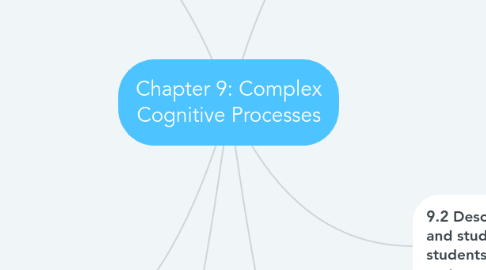
1. 9.3 Explain the processes involved in problem solving and the factors that can interfere with successful problem solving
1.1. A problem is any situation in which you are trying to reach some goal and must find a means to do so. Problem solving is creating new solutions for problems.
1.2. The process involved in problem solving
1.2.1. Problem Identification, Defining Goals and Representing the Problem, Searching for Possible Solution Strategies, Anticipating, Acting, and Looking Back
1.3. Factors That can interfere with successful problem solving:
1.3.1. Functional fixedness: an inability to use objects or tools in a new way.
1.3.2. Representativeness heuristic: judging the likelihood of an event based on how well the events match your prototypes – what you think is representative of the category.
1.3.3. Availability heuristic: judging the likelihood of an event based on what is available in your memory, assuming those easily remembered events are common.
1.3.4. Belief perseverance: the tendency to hold on to beliefs, even in the face of contradictory evidence.
1.3.5. Confirmation bias: seeking information that confirms our choices and beliefs, while ignoring disconfirming evidence.
2. 9.4 Identify factors that influence students' abilities to think critically and to form and support arguments.
2.1. Dialogue
2.1.1. Teachers pose questions and encourage students to dialogue through whole class and small group discussion, debates, Socratic dialogue, or written exchanges.
2.2. Authentic Instruction:
2.2.1. Teachers focus the dialogue on problems that make sense to the students using role-plays, simulations, case studies, or ethical dilemmas, for example
2.3. Mentorship:
2.3.1. One-to-one mentoring for students from teachers, coaches, or other adults also supports the development of critical thinking.
3. 9.5 Discuss how, why, and when knowledge learned in one situation might be applied to new situations and problems.
3.1. Researchers have distinguished between the automatic, direct use of skills such as reading or writing in everyday applications and the thoughtful transfer of knowledge and strategies to arrive at creative solutions to problems.
3.2. Thoughtful transfer is involving two processes – initial learning and reusing or applying what was learned.
3.3. What is worth learning? The learning of basic skills such as reading, writing, computing, cooperating, and speaking will definitely transfer to other situations because these skills are necessary for later work both in and out of school.
3.4. For basic skills, greater transfer can also be ensured by overlearning, practicing a skill past the point of mastery.
3.5. Three stages in developing strategic transfer, acquisition phase, retention phase, transfer phase.
4. 9.1 Discuss the roles of metacognition in learning and remembering
4.1. Metacognition is higher-order knowledge about your own thinking as well as your ability to use this knowledge to manage your own cognitive processes – such as comprehension or problem solving.
4.2. Metacognition consists of knowledge and skills - knowledge about our own information-processing capabilities, the cognitive tasks you face, and the strategies needed to cope with those tasks.
4.3. Metacognition involves three kinds of knowledge
4.3.1. Declarative knowledge - about yourself as a learner, the factors that influence your task - knowing what to do.
4.3.2. Procedural knowledge or knowing how to use the strategies.
4.3.3. Self-regulatory knowledge - to ensure the completion of the task - knowing the conditions, when and why, to apply the procedures and strategies.
4.4. Metacognition is the strategic application of this declarative, procedural, and self-regulatory knowledge to accomplish goals and solve problems.
5. 9.2 Describe several learning and study strategies that help students develop their metacognitive abilities
5.1. KWL is a strategy to guide reading and inquiry: Before – What do I already know? What do I want to know? After – what have I learned?
5.2. To use underlining and note taking effectively, you must identify main ideas. In addition, you must understand the organization of the text or lecture - the connections and relationships among ideas.
5.3. Cmaps are tools for concept mapping developed by the institute for Human and Machine Cognition that are connected to many knowledge maps and other resources on the internet.
5.4. READS is a five-step reading strategy: Review headings; Examine boldface words; Ask, “What do I expect to learn?”; Do it – Read; Summarize in your own words.
6. 9.6 Explain what characterizes robust knowledge, how to recognize it, and how teaching it can develop robust knowledge.
6.1. What is Robust Knowledge?
6.1.1. The study of expertise points to three important characteristics of robust knowledge – it is deep, connected, and coherent
6.1.1.1. Deep knowledge is knowledge about underlying principles that allows experts to recognize the same principle-based features in seemingly different problems.
6.1.1.2. Connected knowledge means many separate bits of information are linked.
6.1.1.3. Coherent knowledge is consistent and has no contradictions.
6.2. Recognizing robust knowledge
6.2.1. In terms of perceiving and representing the problem, novices focus on surface features, whereas experts focus on the structure and larger concepts underlying the problem.
6.3. Teaching For Robust Knowledge
6.3.1. Four strategies that we have covered in this chapter and that can be incorporated into most teaching approaches: practice, worked, examples, analogies, and self-explanation.
